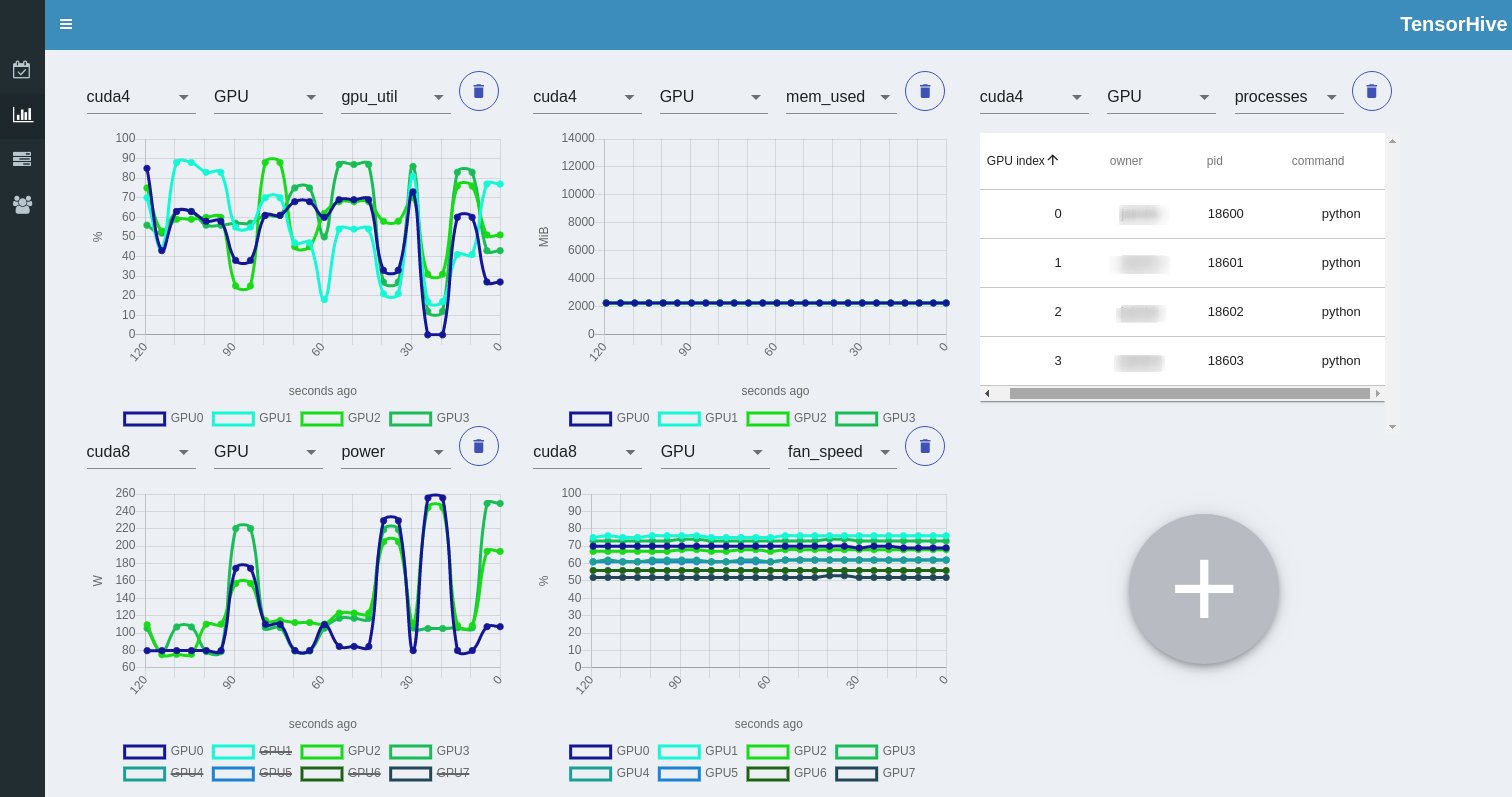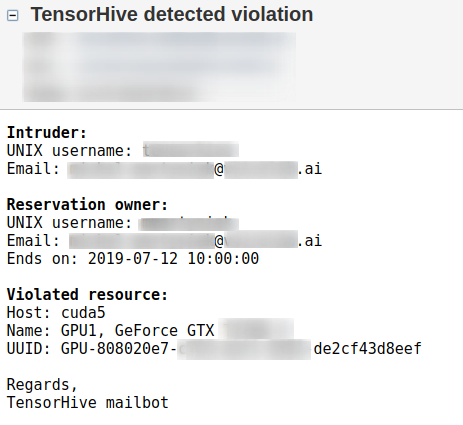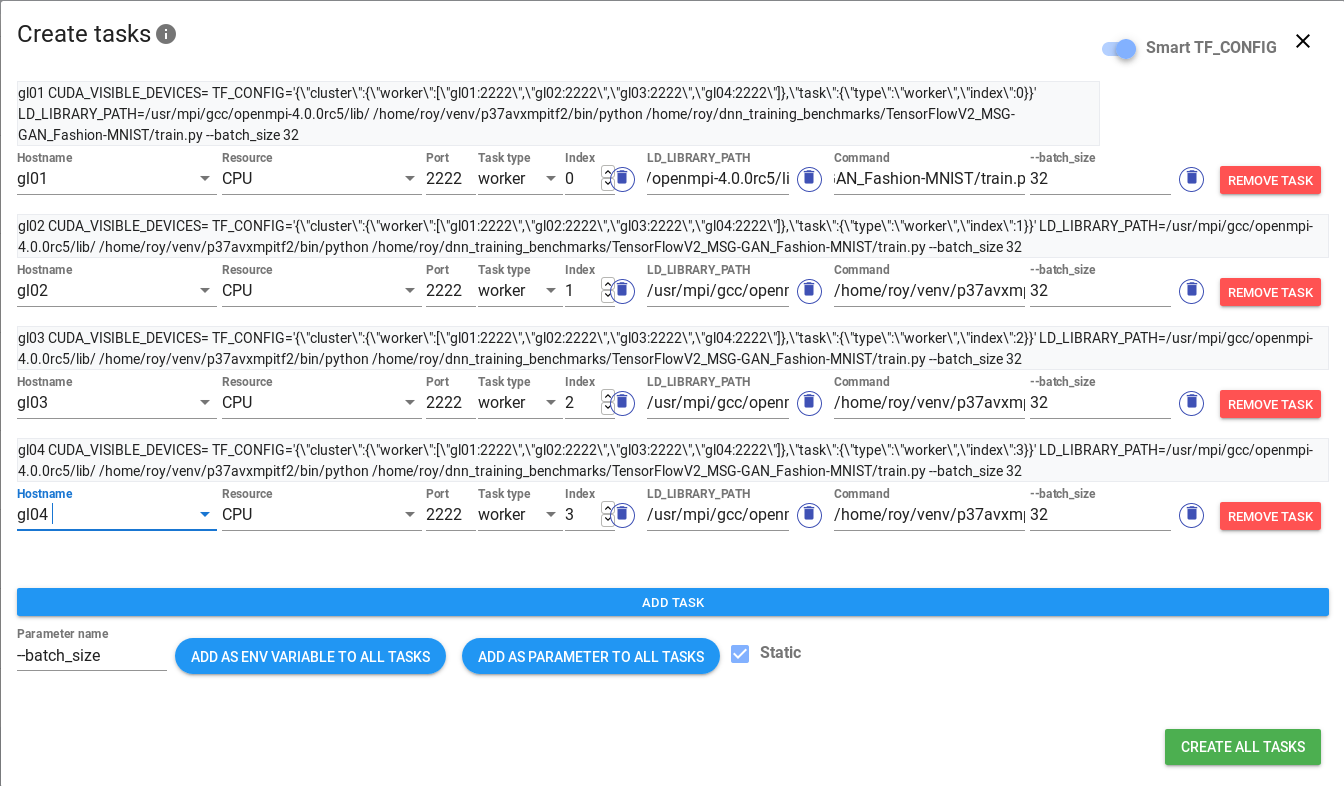TensorHive is an open source system for monitoring and managing computing resources across multiple hosts. It solves the most common problems and nightmares about accessing and sharing your AI-oriented infrastructure across multiple, often competing users.
It's designed with simplicity, flexibility and configuration-friendliness in mind.
Our goal is to provide solutions for painful problems that ML engineers often have to struggle with when working with remote machines in order to run neural network trainings.
- You're an admin, who is responsible for managing a cluster (or multiple servers) with powerful GPUs installed.
- 😠 There are more users than resources, so they have to compete for it, but you don't know how to deal with that chaos
- 🌊 Other popular tools are simply an overkill, have different purpose or require a lot of time to spend on reading documentation, installation and configuration (Grafana, Kubernetes, Slurm)
- 🐧 People using your infrastructure expect only one interface for all the things related to training models (besides terminal): monitoring, reservation calendar and scheduling distributed jobs
- 💥 Can't risk messing up sensitive configuration by installing software on each individual machine, prefering centralized solution which can be managed from one place
- You're a standalone user who has access to beefy GPUs scattered across multiple machines.
- 〽️ You want to be able to determine if batch size is too small or if there's a bottleneck when moving data from memory to GPU - charts with metrics such as
gpu_util,mem_util,mem_usedare great for this purpose - 📅 Visualizing names of training experiments using calendar helps you track how you're progressing on the project
- 🐍 Launching distributed trainings is essential for you, no matter what the framework is
- 😵 Managing a list of training commands for all your distributed training experiments drives you nuts
- 💤 Remembering to manually launch the training before going sleep is no fun anymore
0️⃣ Dead-simple one-machine installation and configuration, no sudo requirements
1️⃣ Users can make GPU reservations for specific time range in advance via reservation mechanism
➡️ no more frustration caused by rules: "first come, first served" or "the law of the jungle".
2️⃣ Users can prepare and schedule custom tasks (commands) to be run on selected GPUs and hosts
➡️ automate and simplify distributed trainings - "one button to rule them all"
3️⃣ Gather all useful GPU metrics, from all configured hosts in one dashboard
➡️ no more manual logging in to each individual machine in order to check if GPU is currently in use or not
For more details, check out the full list of features.
- All nodes must be accessible via SSH, without password, using SSH Key-Based Authentication (How to set up SSH keys - explained in Quickstart section)
- Only NVIDIA GPUs are supported (relying on
nvidia-smicommand) - Currently TensorHive assumes that all users who want to register into the system must have identical UNIX usernames on all nodes configured by TensorHive administrator (not relevant for standalone developers)
pip install tensorhive(optional) For development purposes we encourage separation from your current python packages using e.g. virtualenv, Anaconda.
git clone https://github.com/roscisz/TensorHive.git && cd TensorHive
pip install -e .TensorHive is already shipped with newest web app build, but in case you modify the source, you can can build it with make app (currently on master branch). For more useful commands see our Makefile.
Build tested with Node v10.15.2 and npm 5.8.0
The init command will guide you through basic configuration process:
tensorhive init
You can check connectivity with the configured hosts using the test command.
tensorhive test
(optional) If you want to allow your UNIX users to set up their TensorHive accounts on their own and run distributed
programs through Task execution plugin, use the key command to generate the SSH key for TensorHive:
tensorhive key
Now you should be ready to launch a TensorHive instance:
tensorhive
Web application and API Documentation can be accessed via URLs highlighted in green (Ctrl + click to open in browser).
You can fully customize TensorHive behaviours via INI configuration files (which will be created automatically after tensorhive init):
~/.config/TensorHive/main_config.ini
~/.config/TensorHive/mailbot_config.ini
~/.config/TensorHive/hosts_config.ini
Accessible infrastructure can be monitored in the Nodes overview tab. Sample screenshot: Here you can add new watches, select metrics and monitor ongoing GPU processes and its' owners.
Each column represents all reservation events for a GPU on a given day. In order to make a new reservation simply click and drag with your mouse, select GPU(s), add some meaningful title, optionally adjust time range.
If there are many hosts and GPUs in our infrastructure, you can use our simplified, horizontal calendar to quickly identify empty time slots and filter out already reserved GPUs.
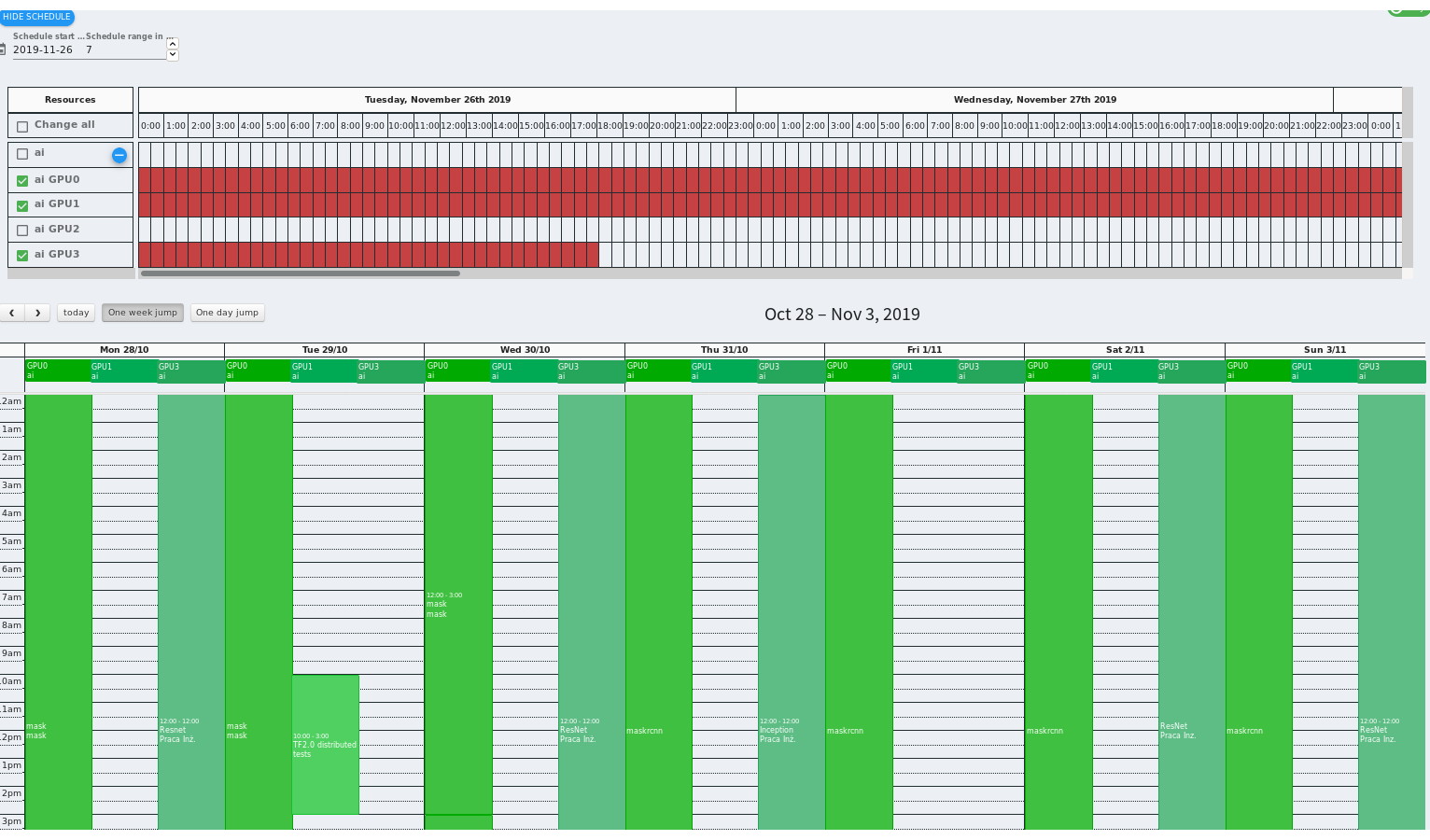
From now on, only your processes are eligible to run on reserved GPU(s). TensorHive periodically checks if some other user has violated it. He will be spammed with warnings on all his PTYs, emailed every once in a while, additionally admin will also be notified (it all depends on the configuration).
| Terminal warning | Email warning |
|---|---|
 |
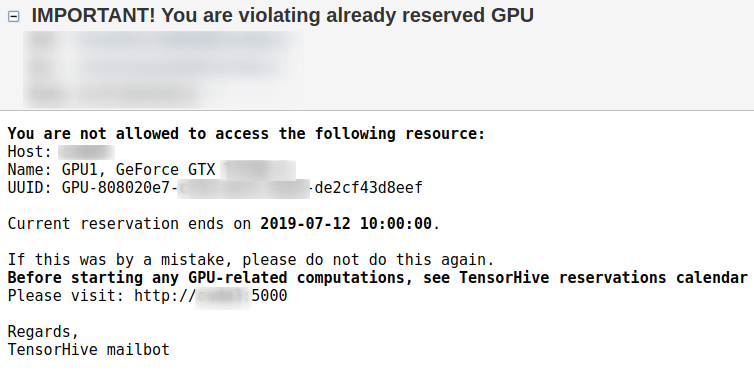 |
Thanks to the Task execution module, you can define commands for tasks you want to run on any configured nodes.
You can manage them manually or set spawn/terminate date.
Commands are run within screen session, so attaching to it while they are running is a piece of cake.
It provides a simple, but flexible (framework-agnostic) command templating mechanism that will help you automate multi-node trainings. Additionally, specialized templates help to conveniently set proper parameters for chosen well known frameworks:
In the examples
directory, you will find sample scenarios of using the Task execution module for various
frameworks and computing environments.
TensorHive requires that users who want to use this feature must append TensorHive's public key to their ~/.ssh/authorized_keys on all nodes they want to connect to.
- 🔎 Monitor metrics on each host
- ™️ Nvidia GPUs
- 📟 CPU, RAM
- 📂 HDD
- 🛃 Protection of reserved resources
-
⚠️ Send warning messages to terminal of users who violate the rules - 📭 Send e-mail warnings
- 💣 Kill unwanted processes
-
- 🚀 Task execution and scheduling
- 🗝️ Execute any command in the name of a user
- ⏰ Schedule spawn and termination
- 🔁 Synchronize process status
- 🏭 Use
screencommand as backend - user can easily attach to running task - 💀 Remote process interruption, termination and kill
- 💾 Save stdout to disk
- 📄 Capture stderr
- ⌚ Track wasted (idle) time during reservation
- 🔪 Gather and calculate average gpu and mem utilization
- 📢 Remind user when his reservation starts and ends
- 📨 Send e-mail if idle for too long
- 📉 Configurable charts view
- Metrics and active processes
- Detailed hardware specification
- 📆 Calendar view
- Allow making reservations for selected GPUs
- Edit reservations
- Cancel reservations
- Attach jobs to reservation
- 🚼 Task execution
- Create parametrized tasks and assign to hosts, automatically set
CUDA_VISIBLE_DEVICES - Buttons for task spawning/scheduling/termination/killing actions
- Fetch log produced by running task
- Group actions (spawn, schedule, terminate, kill selected)
- Create parametrized tasks and assign to hosts, automatically set
- 📏 Detailed hardware specification panel (CPU clock speed, RAM, etc.)
- 🐧 Admin panel
- User banning
- Accept/reject reservation requests
- Modify rules on-the-fly (without restarting)
- Show popups to users (something like message of the day -
motd)
- Implement command-line app that communicates with core via API
- Migrate all features from web app that don't require GUI (so no charts)
- OpenAPI 2.0 specification with Swagger UI
- User authentication via JWT
| Organization | Hardware | No. users |
|---|---|---|
| NVIDIA DGX Station (4x Tesla V100) + NVIDIA DGX-1 (8x Tesla V100) | 30+ | |
| 20 machines with GTX 1060 each | 20+ | |
| A server with two GPUs shared by the Gradient science club at GUT. | 30+ | |
| 30+ GTX and RTX GPUs | 10+ |
This diagram will help you to grasp the rough concept of the system.
We'd ❤️ to collect your observations, issues and pull requests!
Feel free to report any configuration problems, we will help you.
Currently we are working on user groups for differentiated GPU access control,
grouping tasks into jobs and process-killing reservation violation handler,
deadline - July 2020 ![]() , so stay tuned!
, so stay tuned!
If you consider becoming a contributor, please look at issues labeled as good-first-issue and help wanted.
TensorHive has been greatly supported within a joint project between VoiceLab.ai and Gdańsk University of Technology titled: "Exploration and selection of methods for parallelization of neural network training using multiple GPUs".
Project created and maintained by:
- Paweł Rościszewski (@roscisz)
Michał Martyniak (@micmarty)
- Filip Schodowski (@filschod)
Top contributors:
- Tomasz Menet (@tomenet)
- Dariusz Piotrowski (@PiotrowskiD)
- Karol Draszawka (@szarakawka)

